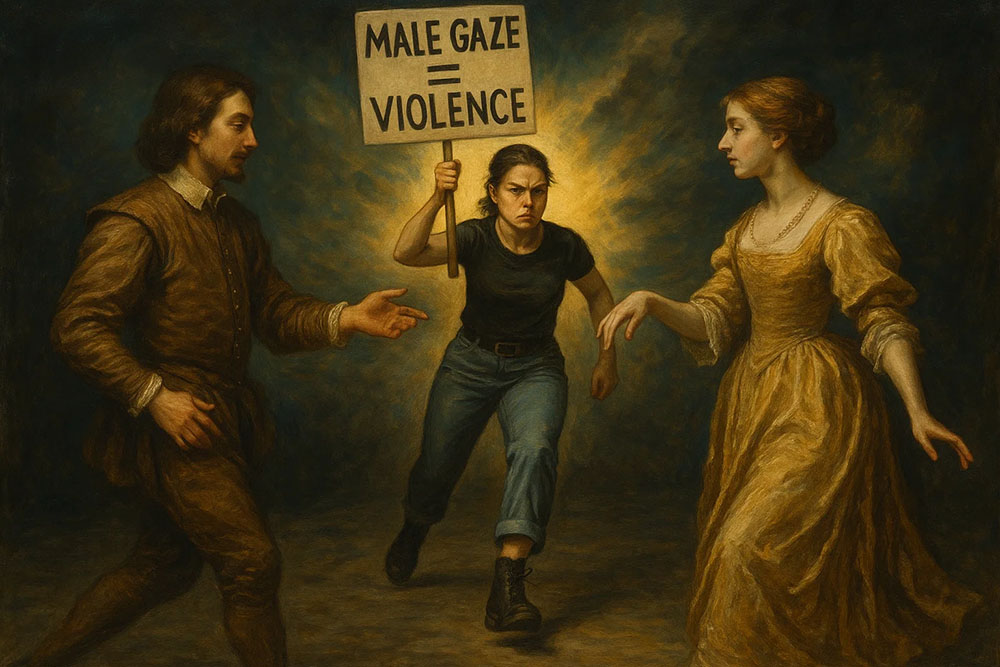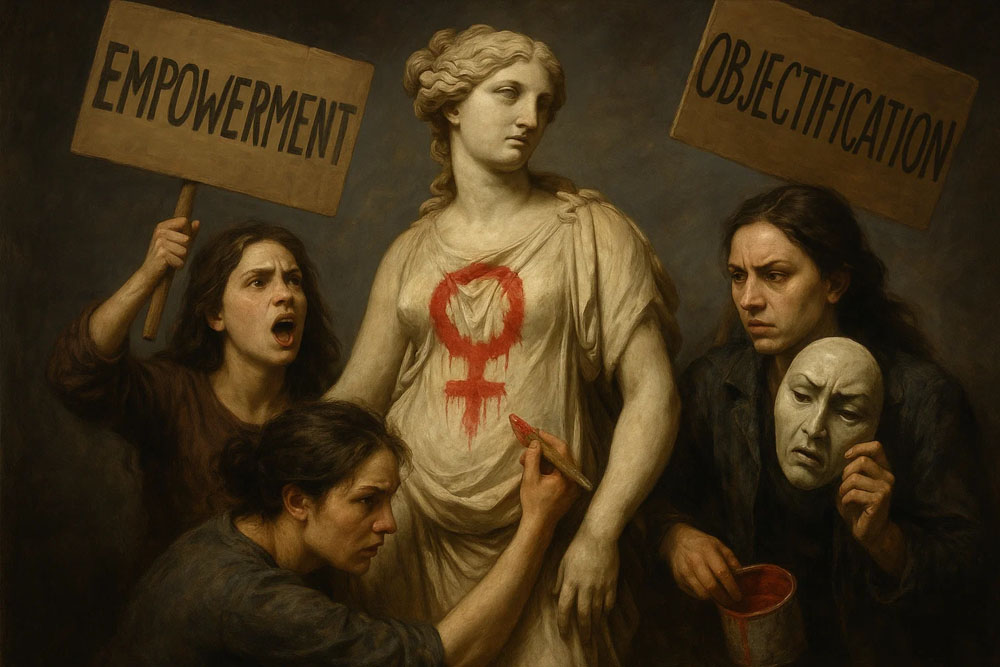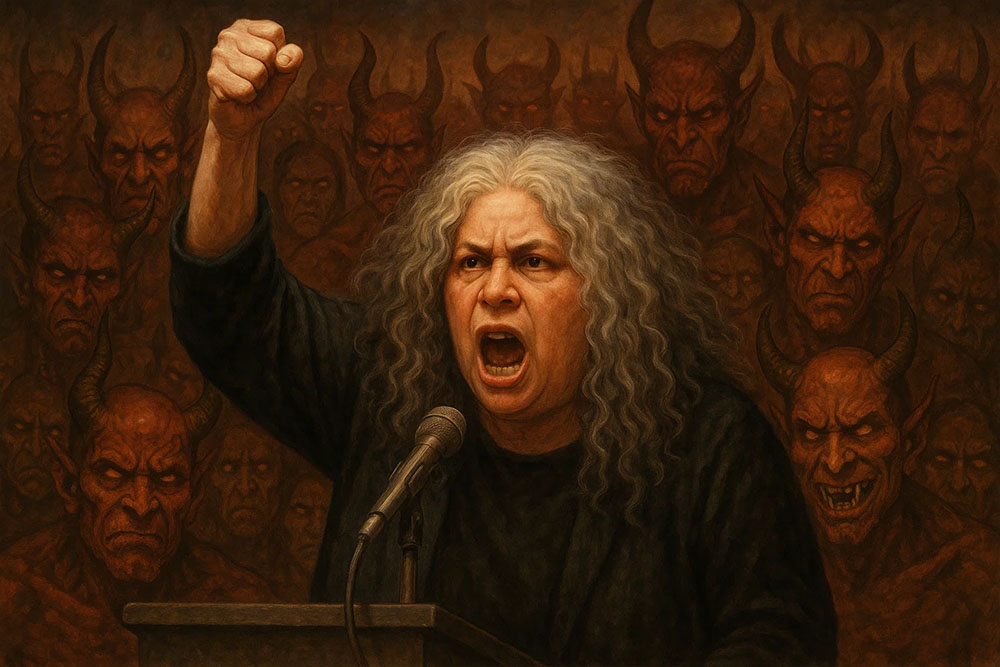Feminism did not arise solely as a movement for justice or equality. It was also, perhaps primarily, a hostile rebellion by less desirable and less competitive women. By redefining the traits that confer social or romantic success, feminism became a vehicle for envy-driven sabotage. The traditional winners — beautiful, feminine, nurturing women — were recast as victims or traitors to the cause, while the bitter and overlooked took the mic and rewrote the rules.
Why This Theory Matters Now
The reason for revisiting this theory is simple: we’re seeing it reemerge. Collective Shout, an Australian activist group led by ideologically rigid moralists, has recently begun targeting the video game industry under the familiar guise of “protecting women and children.” Their real goal is the same old playbook: to shame male desire, punish feminine beauty, and impose a puritanical vision of gender where no one is allowed to be attractive, desired, or free.

This group doesn’t represent women. It represents a certain type of woman — one who uses moral outrage to control others. And it’s a reminder that feminism, far from being a force of freedom, often functions as a vehicle for envy masquerading as virtue.
The Dirty Secret of Female Competition
For all its talk of “sisterhood” and “solidarity,” feminism has always carried a hidden contradiction: women are not a monolith. They do not operate as one unified class. In fact, throughout history, women have competed with one another just as fiercely as men — only in different ways.
Where male competition tends to be direct — strength, status, success — female competition is often covert: reputation, exclusion, gossip, and moral posturing. It’s a social game, not a physical one. Women don’t knock each other out in the ring. They ice each other out in the group chat.
Evolutionary psychology has long documented this dynamic. Biologically, women compete for the highest-quality male mates. And in environments where male resources, loyalty, and attention are limited, women fight not with fists, but with narratives. They signal virtue, accuse rivals, and shift social norms to advantage themselves. It’s cutthroat — just with a smile.
Feminism, at its root, was sold as a collective uprising — women rising together against male power. But that’s only half the story. The other half is far more uncomfortable: feminism was also a civil war between women. A new class of women — less traditionally attractive, less successful in the biological mating game — used ideology to upend the rules of femininity itself.

Instead of celebrating beauty, grace, fertility, or gentleness — the traits that traditionally gave women status and success — feminism elevated traits that had previously been seen as competitive liabilities: aggression, androgyny, sexual bitterness, and careerism. Suddenly, the women who were once called “masculine” or “abrasive” were rebranded as “empowered.”
This wasn’t a moral revolution. It was a strategic sabotage. A new class of women, fed up with losing the evolutionary game, redefined the scoreboard. They didn’t just demand power from men. They demanded that other women stop winning.
This is a form of cultural Tall Poppy Syndrome — where the women who excel in beauty, grace, or natural femininity are punished not for wrongdoing, but for standing out. Feminism didn’t just fail to protect those women — it taught others to resent and attack them.
Ressentiment in Lipstick: The Nietzschean Lens
Feminism’s ideological engine runs on a fuel that Nietzsche understood well: ressentiment. It’s the moral inversion that happens when the powerless can’t defeat the powerful directly, so they redefine power itself as evil. Rather than admit envy, they redefine virtue.
Feminism claimed it was about justice, but it worked by redefining female value. Femininity was no longer defined by beauty, fertility, grace, or nurturing. Instead, the new values became independence, confrontation, sarcasm, and refusal. Feminism did not elevate women to match men; it rebranded masculine traits as superior and shamed women into adopting them.
But here’s the deeper twist: feminism’s new ideal woman wasn’t admired by men or women. She was feared, tolerated, or obeyed. She had no warmth, no softness, no mystery. The movement had replaced the magnetic feminine with the managerial feminine — a bitter HR rep with a grudge.

And that wasn’t an accident. It was the revenge of the unchosen.
Redefining the Sexual Marketplace
Feminism has always claimed to challenge male dominance, but it spent just as much time punishing female success. The old system rewarded traits that attracted male commitment: beauty, fidelity, kindness, grace. Feminism attacked all of them.
It taught women that beauty was a trap, that nurturing was weakness, that seeking a man’s protection was betrayal. Men, meanwhile, were shamed for their desire for traditionally feminine women. Feminism told men their preferences were patriarchal, shallow, and dangerous. It tried to reprogram attraction itself.
In other words, feminism tried to short-circuit the mating dance. And it mostly succeeded. Modern men are increasingly disengaged, either going abroad for wives, giving up entirely, or quietly dating traditional women in defiance of the cultural script.
The Myth of Objectification (and the Short-Circuiting of Courtship)
The term “objectification” as it relates to male attraction was popularized by radical Jewish feminist Andrea Dworkin. She used it to argue that when men express desire toward women, they are reducing them to non-persons — mere bodies, stripped of agency or worth. This concept became a central dogma of second-wave feminism, and its ripple effects continue to shape how men and women interact to this day.
Feminism taught generations of women that male attraction is inherently degrading — that when a man notices a woman’s body, he is objectifying her. But this is a fallacy rooted in envy and resentment, not truth.
Physical attraction is not objectification. It’s recognition. A person’s physique reflects their biology, their habits, their health, and their sexual value. This is true not just in humans but throughout nature. Courtship rituals are everywhere: bright plumage, stylized motion, physical display. Human beauty is biological clickbait — it grabs attention so that something deeper can be discovered.
To be desired is not to be dehumanized. It is to be seen. But feminism turned visibility into a liability. Admiration became aggression. Courtship became coercion. Men were told that noticing a woman was predatory. Women were told that being noticed was victimization.
The result? A romantic cold war. Men now avoid compliments, skip office flirtation, and stay silent in gyms and universities. Dating has become bureaucratic. Women who once basked in attention now ask why no one notices them. They made themselves invisible — and now they miss being seen.
Dworkin’s Resentment in the Flesh
Normally, it would be ad hominem to critique a thinker based on her appearance. But when a woman builds her career on the idea that beauty is oppression and desire is violence, her own relationship to beauty becomes relevant.
Andrea Dworkin was not a woman known for attractiveness, nor did she aspire to it. She rejected femininity, projected hostility, and wrote with obvious fury. Her ideology was not born of love for women, but of hatred for the dynamics she could never benefit from. Her fury wasn’t abstract. It was rooted in personal trauma. After fleeing an abusive husband in 1971, Dworkin concluded that all sex was violence and all male desire was coercive. Her ideology wasn’t built from evidence — it was built from pain. She couldn’t win the mating game, so she condemned the game itself.

The rhetoric she helped popularize, particularly the term objectification, quickly escaped the feminist seminar room and entered the bloodstream of public policy, education, and moral crusading. Within a decade, it had become a go-to justification not only for secular feminists, but for religious anti-porn activists, law enforcement initiatives, and bureaucrats seeking moral authority. What started as radical critique became a widely accepted weapon in cultural censorship.
Dworkin’s worldview was so poisoned by trauma and ideological absolutism that she didn’t just attack pornography—she attacked all consensual sex between men and women. In her first major work, Woman Hating (1974), she argued that heterosexual sex itself was a form of subjugation and claimed that marriage was “a legal license to rape.” This wasn’t a critique of exploitation—it was a blanket condemnation of intimacy between the sexes. And yet, her ideas seeped into courts, classrooms, and Christian pulpits alike.
Her legacy is not moral clarity. It is sublimated bitterness. And modern feminism, whether it admits it or not, still draws from her poisoned well.
The Fallout: Lonely Women and Disengaged Men
The world feminism built is one of mutual suspicion. Women are told that love is dangerous. Men are told that desire is suspect. The dating world is marked by fear, legalism, and resentment. Nobody dances anymore.
Feminism demanded men change their preferences, their instincts, their very nature. But biology doesn’t yield to ideology. And now the very women who cheered the destruction of courtship are asking: where are all the good men?
They’re gone. Or worse, they’re silent. Because feminism taught them that their attention is violence, their masculinity is toxic, and their love is conditional on obedience. And in doing so, it killed the very thing women secretly crave: the warmth of being wanted by a man who isn’t afraid of them.
The Sisterhood Lie
Feminism presents itself as a united front — a global sisterhood of solidarity, empowerment, and shared struggle. But this image is largely propaganda. In reality, women are highly competitive with one another, and the feminist movement often intensifies that competition rather than softens it.
Behind the hashtags and panel discussions is a brutal reality: women frequently sabotage each other, especially when social status, male attention, or institutional power are at stake. They do it through whisper networks, moral accusations, exclusion games, and performative virtue. The sisterhood is real — until one woman starts outshining the rest. Then the knives come out.

This isn’t slander. It’s human nature — and evolutionary psychology backs it up. Feminism didn’t eliminate female competition. It merely cloaked it in moral language, where attacks come not in jealousy but in the name of “empowerment” or “safety.” The result is a culture where women are punished not just by men, but increasingly by each other — especially if they commit the modern sins of being beautiful, traditional, or happy in a role the sisterhood disapproves of.
Conclusion: Feminism as Envy in Drag
The feminist worldview, with its core assumptions about sex, power, and male desire, has done immense cultural damage. It dismantled courtship, shamed femininity, and turned mutual attraction into a minefield. For decades, women were told to suppress their instincts, compete with men, and distrust love. But the tide is beginning to turn. More and more women are quietly rebelling against the feminist script — choosing marriage, embracing motherhood, rejecting victimhood, and seeking fulfillment not through ideology, but through relationship. The lies are cracking. And the rebellion, though soft-spoken, is growing.
Feminism did not remain confined to women’s issues. It polluted the broader culture with corrosive assumptions: that power is the only moral good, that men and women are enemies, and that traditional values are oppressive relics. These ideas seeped into schools, entertainment, government, and even churches. They hollowed out the foundations of trust between the sexes, poisoned boys against masculinity, and taught girls to see victimhood as virtue. The result is a confused, atomized, and deeply unhappy society — one that rewards grievance, punishes beauty, and fears love.
Feminism did not merely elevate women. It punished femininity. It wasn’t a sisterhood. It was a hostile takeover by the women who couldn’t win under the old rules.
By reframing beauty as oppression, desire as danger, and marriage as slavery, feminism inverted the hierarchy. But it didn’t create equality. It created misery. Feminism wasn’t a movement for freedom. It was a movement for revenge.
And the women who once laughed at the old ways are now quietly mourning what they destroyed: a world where men and women could fall in love without legal counsel.
—Wolfshead





You and Nietzsche summed it up nicely. The resentment is driven by base things, envy, jealousy. As usual, socialism/feminism doesn’t create or nurture, it can only drag down and destroy!
Just wait, “Sydney Sweeney has great jeans” got quite a lot of ladies fuming. They cannot get her yet, but they will remember. The only thing they can do right now is to ignore her, as they don’t have an angle of attack yet.
Oh my, it didn’t take more than three days.
“Sydney Sweeney being in an American Eagle ad is “fascist propaganda” according to the triggered tiktok libs”
Just read this on Quillette: https://quillette.com/2025/07/11/when-women-are-radicalised/. A different angle from where you’re writing, but I think the two articles are related.